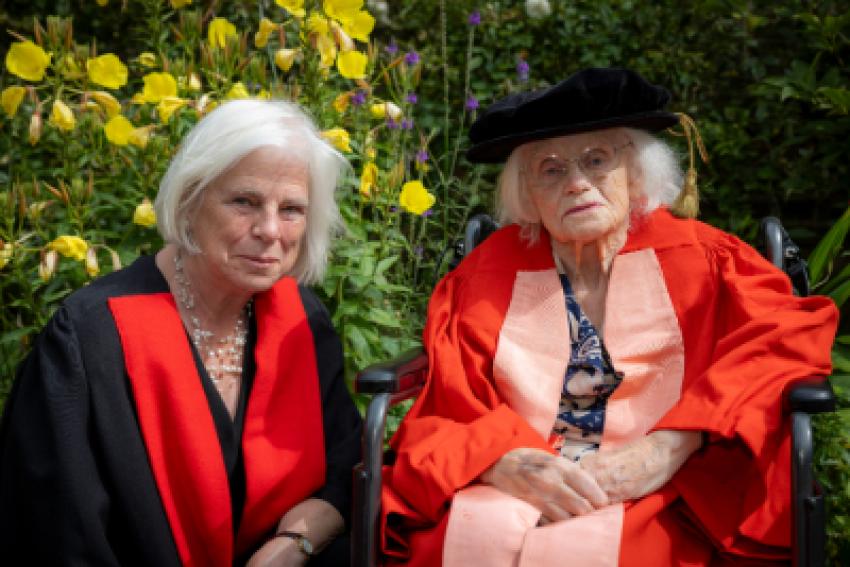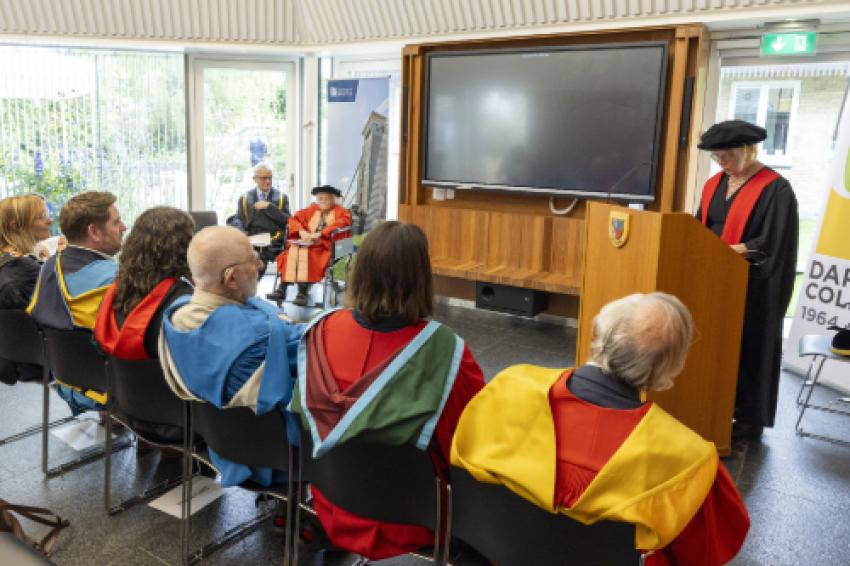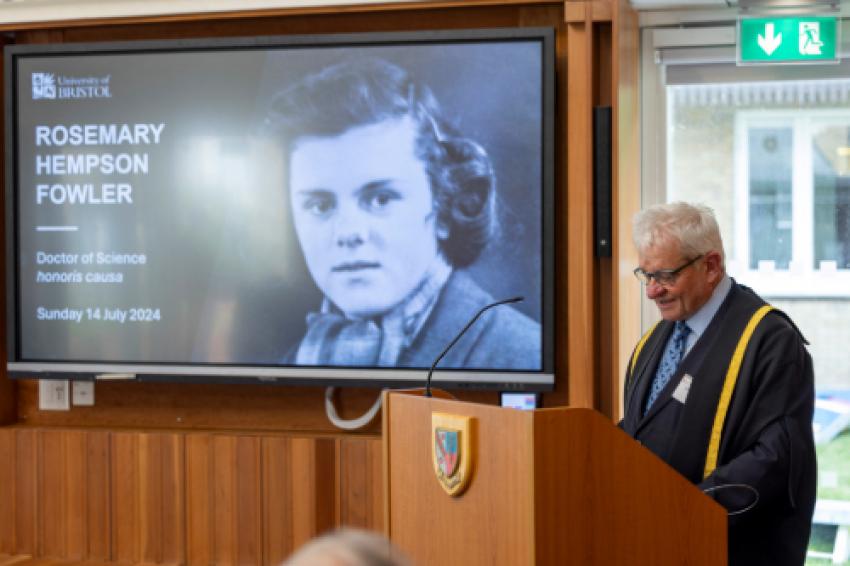A pioneering physicist who gave up her PhD 75 years ago to have a family has been made an honorary Doctor of Science by her old university.
Dr Rosemary Fowler’s discoveries at the University of Bristol in 1948 helped change our understanding of physics. Nearly eight decades on, the scientific journal Nature described her work as “[setting] events in motion that would rewrite the laws of physics”.
She also has a Royal Astronomical Society prize named after her - the Fowler Award - which was established in 2004 thanks to her generosity.
Dr Fowler's discovery of the Kaon helped lead to a revolution in the theory of particle physics. It continues to be proven correct today – predicting particles such as the Higgs boson, discovered at CERN in Geneva.
But in the difficult conditions of post-war Britain, Dr Fowler made the decision to leave academia when she married fellow physicist Peter Fowler in 1949.
Seventy-five years on, in a private graduation ceremony close to her Cambridge home, Dr Fowler was conferred the honorary doctorate by University of Bristol chancellor Sir Paul Nurse.
The ceremony was attended by Dr Fowler's children, grandchildren and great-grandchildren, many of whom are scientists, along with friends and University of Bristol staff.
Dr Fowler, now 98, said she felt “very honoured”, adding humbly “but I haven’t done anything since to deserve special respect”.
Sir Paul, a Nobel Prize-winning scientist, praised Dr Fowler’s “intellectual rigour and curiosity” and said she “paved the way for critical discoveries that continue to shape the work of today’s physicists, and our understanding of the universe”.
The annual Fowler Award for early achievement in astronomy is awarded to individuals who have made a particularly noteworthy contribution to astronomy (including emerging areas), within 10 years of completing their PhD. It is named after father and son, Ralph and Peter Fowler, two of the Royal Astronomical Society's most distinguished Fellows, and also after Rosemary Fowler.
In 1948, Bristol’s world-leading cosmic ray physics team, led by Professor Cecil Powell, were hunting for new fundamental particles. They had already found the pion, for which Powell would be awarded the Nobel Prize in 1950.
A 22-year-old Dr Fowler (née Brown) was viewing unusual particle tracks in photographic emulsions that had been exposed to cosmic rays at high altitude on the Jungfraujoch, Switzerland, when she spotted something remarkable – a particle that decayed into three pions.
She said: “I knew at once that it was new and would be very important. We were seeing things that hadn’t been seen before – that’s what research in particle physics was. It was very exciting.”
The first person she told was a fellow student, Peter Fowler – her future husband.
The track she was looking at, later labelled ‘k’, was evidence of an unknown particle, now known as the kaon or K meson. Puzzlingly, the k-track was the mirror image of a particle seen before by colleagues in Manchester. But the Manchester team’s track decayed into two pions, not three.
Dr Fowler had ‘cracked the mirror’. Trying to understand how these mirror images were the same, yet behaved differently, helped lead to a revolution in the theory of particle physics.
The next year, she left the university, having published her revolutionary discovery in three ‘Brown et al.’ academic papers with Powell’s team, including two in Nature. Strongly supported by Dr Fowler, her husband Peter FRS went on to have a very distinguished career.
Dr Fowler was born in Suffolk in 1926, and grew up in Malta, Portsmouth and Bath as her family travelled for her father’s job as a Royal Navy engineer. During the Second World War her school moved to the countryside, and she recalls their family home near Bath being strafed by the Luftwaffe.
To a young Dr Fowler “maths and science were easy, writing essays was hard”, and she was the only girl in her year to go to university. For her first undergraduate year at Bristol she would take two buses to reach the university. She later moved to the city to complete her BSc, becoming one of the first women to be awarded a First in Physics, and she remained a Bristol resident until recently.
Her husband, who died aged 73 in 1996, was described in an obituary by the Independent as “one of the outstanding physicists of his generation”.
All three of the couple's children went on to study science.
Anne Fowler studied sciences at Bristol and Aston and has a career in music, while Sue Fowler studied Natural Sciences and Geophysics at Cambridge and went on to a career in industry.
Mary Fowler studied Maths and then Geophysics at Cambridge and had an academic career in Switzerland, Canada, London and finally Cambridge, where she was the Master of Darwin College from 2012 to 2020.
Mary said: “I’m really pleased for my mother. As a child I wanted to be a physicist because it seemed to be so exciting. With both parents being physicists, physics and research was a normal topic of conversation across the kitchen table.
“My mother remained very connected with the Bristol Physics Department, and the university, because my father joined the academic staff as did a number of their student friends.”
Bristol was one of the first universities to admit women on an equal basis to men. Its first female lecturer, Mary Paley, taught classes at University College Bristol (the precursor to the University of Bristol) until 1881.
Women now make up 55 per cent of its workforce and many of its senior team, including its Vice-Chancellor and President Evelyn Welch, are women.
You can read more about Dr Fowler and her discovery in this Nature article.
Media contacts
Sam Tonkin
Royal Astronomical Society
Mob: +44 (0)7802 877 700
Notes for editors
About the Royal Astronomical Society
The Royal Astronomical Society (RAS), founded in 1820, encourages and promotes the study of astronomy, solar-system science, geophysics and closely related branches of science.
The RAS organises scientific meetings, publishes international research and review journals, recognises outstanding achievements by the award of medals and prizes, maintains an extensive library, supports education through grants and outreach activities and represents UK astronomy nationally and internationally. Its more than 4,000 members (Fellows), a third based overseas, include scientific researchers in universities, observatories and laboratories as well as historians of astronomy and others.
The RAS accepts papers for its journals based on the principle of peer review, in which fellow experts on the editorial boards accept the paper as worth considering. The Society issues press releases based on a similar principle, but the organisations and scientists concerned have overall responsibility for their content.
Keep up with the RAS on X, Facebook, LinkedIn and YouTube.




